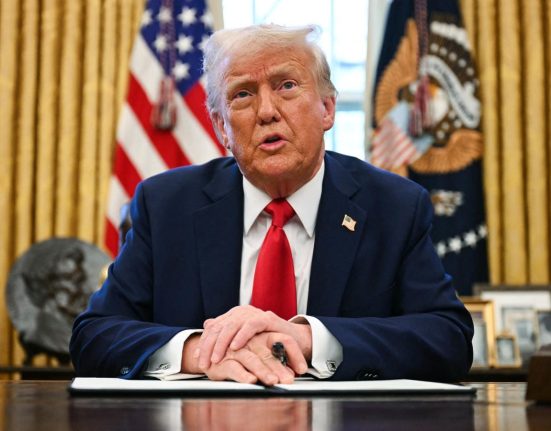BERLIN, GERMANY – JANUARY 25: In this photo illustration model coins of the cryptocurrencies … More
In May 2024, prospects for the United States becoming a global innovation center for digital assets and other promising blockchain technologies were gloomy. Regulatory uncertainty and general hostility from Washington presented high hurdles to industry growth. But the perseverance of determined entrepreneurs, changes in U.S. political leadership, and a growing appreciation for the economic importance and broader application of these cost-saving technologies have changed perceptions and raised expectations that the United States will become “the crypto capital of the world.” The ball is now in Congress’ court.
Throughout the previous four years, firms and investors seeking to develop markets for cryptocurrency in the United States were stymied by an antagonistic Securities and Exchange Commission chairman, who regarded the industry as “rife with hucksters, fraudsters, scam artists.” Rather than offer a clear regulatory framework within which crypto firms could operate, Chairman Gary Gensler opted for what became known as “regulation by enforcement” – the pursuit of legal enforcement to build precedent rather than the promulgation of broad rules.
Gensler insisted on applying existing securities laws to crypto companies and individuals, rather than developing new regulations to account for the unique features of digital assets. Tokens classified as securities would require issuing firms to register with the SEC and provide certain disclosures to investors, but many argued that crypto tokens are more like commodities than securities. The issue came to a head in the SEC’s lawsuit against the payments company Ripple, where Judge Analisa Torres of the Southern District of New York ruled that the XRP token itself, which Ripple has sold, is not a security when traded on public exchanges and does not “embody” any investment contract.
Gensler appealed the ruling, while resorting to other spiteful actions intended to frustrate the access of crypto firms to mainstream banking, such as publishing Staff Accounting Bulletin No. 121 (SAB21) – an SEC guidance document making it difficult for financial institutions to provide custodial services for cryptocurrencies. It was a bridge too far. Gensler was rebuked by the Government Accountability Office for skirting the statutory rule-making process with SAB21 by failing to notify Congress, as required under the Congressional Review Act.
Seeking change through the political process, Ripple and Coinbase, the leading U.S. crypto exchange, pooled resources for the 2024 election campaigns through the Fairshake PAC, raising millions of dollars for pro-crypto candidates. Those donations seem to have gotten the attention of Congress. The Senate promptly overturned SAB21 with the support of 12 Democrats, including then Senate leader Chuck Schumer. And, around the same time, with the support of 70 Democrats including Nancy Pelosi, the House passed by a vote of 279-136 the Financial Innovation and Technology for the 21st Century Act, known as FIT21, which removed any doubt that digital assets are commodities to be regulated by Commodities Futures Trading Commission and not securities to be regulated by the SEC.
Today, Gensler is gone. There is a greater appreciation than ever in Congress for the importance of these technologies to the economy’s future. And the White House has been working with Capitol Hill, the various regulatory agencies, and industry experts to create a sensible regulatory environment, grounded in new, clearly written legislation, that simultaneously protects the public and permits enterprising firms to flourish.
Many great strides toward those aims already have been taken in the first quarter of 2025. On January 20, President Trump established the role of an “AI and Crypto Czar” to ensure the White House has an open channel and a dedicated point person for discussion and collaboration with Congress. Trump issued an executive order establishing a working group dedicated to “Strengthening American Leadership in Digital Financial Technologies,” under the direction of the new Crypto Czar David Sacks, which is tasked with producing a comprehensive report within 180 days that includes legislative and regulatory proposals that would promote U.S. leadership in digital assets and financial technology while protecting economic liberty.
Meanwhile, the SEC has been busy working to reform its own bad habits. On January 23, the SEC officially rescinded SAB121 and then subsequently dropped its numerous lawsuits against Ripple, Coinbase, Kraken and other firms. More recently, the SEC revoked the authority of its Enforcement Director to issue enforcement directives without commissioners giving their approval first. The SEC also established a “Crypto Task Force” dedicated to developing a comprehensive, clear regulatory framework, including rules and guidance, for crypto assets.
The task force is headed by Republican SEC Commissioner Hester Peirce, who noted refreshingly: “Spring signifies new beginnings and we have a new beginning here, a restart of the commission’s approach to crypto regulation.”
One major consideration at the first public meeting of the task force was the question of whether crypto tokens require a new, separate regulatory framework, different from how the SEC oversees securities. Among the concerns of Commissioner Pearce is that legislation must clearly delineate regulatory authority to a single agency lest overlapping rules with multiple agencies render costs and paperwork too burdensome for business. She also seems to favor the permitting of “regulatory sandboxes,” where entrepreneurs can test new products, services, and business models under a regulator’s oversight, allowing for innovation without the full weight of existing regulations, while regulators can gain insights before rendering broad regulatory decisions.
The task force is interested in making sure firms have the room to run and that market competition can reveal winners and losers. But it is also concerned about protecting retail investors from bad actors in the emerging technologies field. Among its first actions, the SEC promptly created the Cyber and Emerging Technologies Unit (CETU) to combat cyber related misconduct. CETU will comprise specialists from across multiple SEC offices.
The White House, last month, issued an executive order to establish a strategic reserve of cryptocurrencies and held a summit for industry leaders at the White House. Ripple CEO Brad Garlinghouse, who attended the summit, said he was extremely pleased to see the administration’s support for regulatory clarity, as well as a Bitcoin reserve and crypto stockpile. XRP is one of the four other cryptocurrencies Trump had suggested may be added to digital asset stockpile.
Other summiteers praised the Trump administration for welcoming collaboration with industry after years in which some felt they were under attack over security and consumer protection issues. Attendees said they were optimistic about working with an administration that views crypto as a mainstream asset class and expressed hope for a straightforward regulatory process.
The most recent good news concerning the SEC is that Paul Atkins, Trump’s nominee to chair the agency, was confirmed by the Senate on April 9. While the SEC—and other regulatory agencies—should provide guidance and expertise to lawmakers, they should refrain from drafting any new crypto regulations until after Congress passes legislation. With most of the crucial pieces in place in the executive branch, all eyes should be turning toward the Congress, which is tasked with crafting new, holistic, clarifying, durable legislation that will provide realistic and reasonable parameters for operating in this space. This includes identifying the activities that require oversight, which regulator has that authority, and which actions run afoul of the law.
It just so happens that both the House of Representatives and the Senate are considering their own promising bills that establish comprehensive regulatory frameworks for payment stablecoins. At the beginning of April, the House Financial Services Committee advanced the Stablecoin Transparency and Accountability for a Better Ledger Economy (STABLE) Act out of committee and is now eligible for a full floor vote. Similarly, the Guiding and Establishing National Innovation for U.S. Stablecoins Act, called the GENIUS Act, took a major step forward when it passed the Senate Banking Committee in early March.
According to several of the 25 U.S. federal lawmakers who participated in the Digital Chamber’s Block Chain event on March 26, the aim on Capitol Hill is to have reconciliation of the bills during the summer and a vote on the final bill before the August recess. The devil, as always, will be in the details. But, in this post-Chevron policy environment, Congress can no longer defer its legislative responsibility to federal agencies by punting on the details and being deliberately vague in the legislative language. It must take responsibility for debating the merits and writing clear, unambiguous laws so that changes in presidential administrations do not invite significant, disruptive changes in the regulatory regimes.
It is now up to Congress to create a predictable environment that enables digital assets and other cutting-edge blockchain technologies to flourish, while protecting retail investors and the public by writing sensible laws that will establish a comprehensive regulatory framework for these industries.







